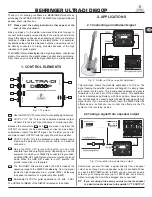
ENGLISH
SAFETY INSTRUCTIONS:
• Read through the instructions carefully before
using this blender for the
fi
rst time. Keep them
for future reference. Inobservance of these
instructions may lead to an accident.
• Only connect it to the voltage stated on the
rating plate.
• This appliance is not intended for use by
persons (including children) with reduced
physical, sensory or mental capabilities, or lack
of experience and knowledge, unless they have
been given supervision or instruction concerning
use of the appliance by a person responsible for
their safety.
• Children should be supervised to ensure that
they do not play with the appliance.
• Always use the blender on a level surface.
• Never insert utensils inside the jug while the
appliance is operating.
• The edge of the blade is very sharp. To avoid
injuries handle the blades with extreme care
when cleaning them.
• Do not operate the appliance with the cable
still coiled.
• Do not unplug it by pulling on the cable or with
wet hands.
• Do not leave the plug hanging freely.
• Do not leave the appliance close to heat
sources or allow the cable to come into contact
with hot surfaces.
• Do not use the appliance if the jug is cracked
or broken.
• Always unplug it from the wall socket when it is
not in use and before cleaning it.
• DO NOT IMMERSE THE MOTOR HOUSING,
CABLE OR PLUG IN WATER OR ANY OTHER
LIQUID.
• Do not use the appliance in the bathroom
or near any source of water. Do not use it
outdoors.
• Do not switch the blender on if either the cable
or plug are damaged, if it can be detected that it
is not operating correctly or if it has suffered any
type of damage.
• Do not leave it unattended while plugged in.
• Do not let the jug over
fl
ow. If liquid gets into the
motor unit, it may damage it.
• This appliance has been designed for domestic
use only.
• The mains cable must not be replaced by the
user. Cable repairs and replacements must
be carried out exclusively by an Authorized
Technical Service Centre.
• This appliance is suitable for use with
foodstuffs.
OPERATION AND USE
- Before using it for the
fi
rst time, wash the
parts which are going to come into contact with
foodstuffs and dry them (see section “Cleaning
and maintenance”).
- Add the ingredients into the jug after having
fi
rst chopped them into small pieces. Always
keep your hands away from the blades. Do not
run the appliance empty, as it may overheat,
and never exceed the maximum quantity of
1250 ml.
- Add some liquid when mixing dry ingredients
or crushing ice. Do not pour very hot or boiling
liquids into the jug.
- Check that the speed selector is set to
0 position (Fig. 1) and put the plug into the power
socket.
- Place the jug onto the motor housing. You may
have to turn it slightly to align the lugs in the base
of the jug with the lugs on the top of the motor
unit. The blender is
fi
tted with a safety switch to
prevent the motor from operating unless the jug
is on its place.
- Do not use the blender without the lid. Place
both the lid and the measuring cup properly
before starting (Fig. 2).
- The blender speed selector has 4 positions
(Fig. 1):
0
- The appliance is switched off.
1
- Low speed, used mainly for liquids and
light applications.
2
- High speed, suitable for solid ingredients
and heavy applications.
Turbo
- Programmed impulse speed (Fig. 3).
Appropriate for ice crushing. This function
will give you a short burst at high speed; it
allows the blender to work using pulses which
permits higher quality results. In this position
the knob is spring-loaded and to come back
to 0 position you just have to release the
knob, which will come directly back to this
0 position.
- Select the suitable speed with the selector
to start the blender up. Do not run the motor
continuously for more than 2 minutes in order
to avoid overheating. After 2 minutes, switch off
the appliance for a few minutes to let the blender
cool down.
Summary of Contents for BS4795
Page 2: ...2 1 3 4 5 6 Fig 1 Fig 2 Fig 3 Fig 4 60ml 30ml...
Page 16: ...1250 0 1 2 4 1 0 1 2 Turbo 3 0 0 2 2...
Page 17: ...4 1250 0 Turbo 3 2002 96 EC...
Page 20: ...1250 1 2 4 1 0 1 2 Turbo 3...
Page 21: ...4 1250 3 2002 96 EC WEEE...
Page 24: ...4 1250 0 3 EC 96 2002 WEEE...
Page 25: ...1250 0 1 2 1 0 1 2 3 0 0...







































